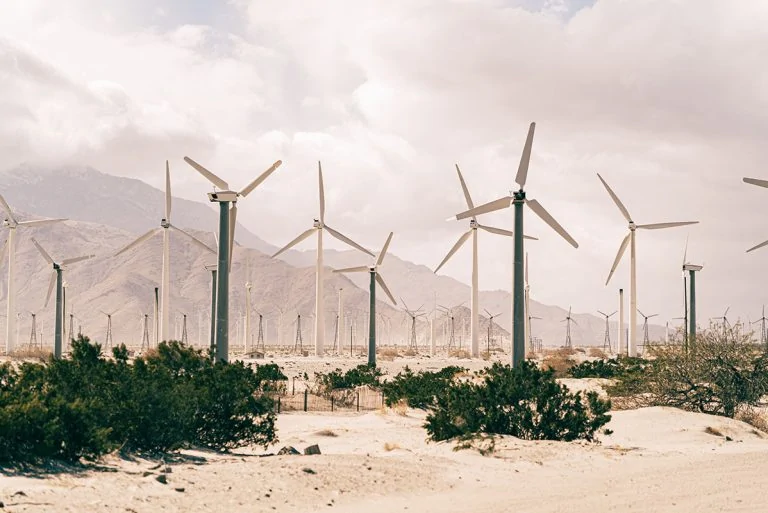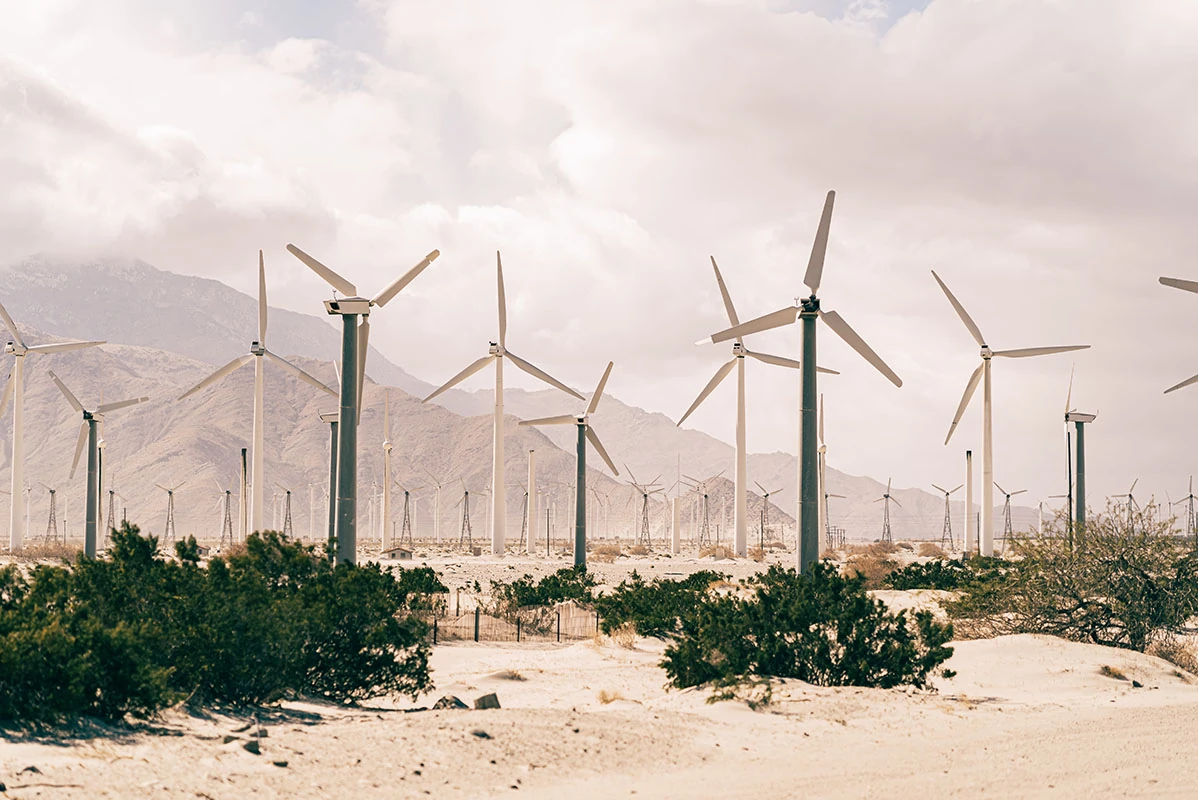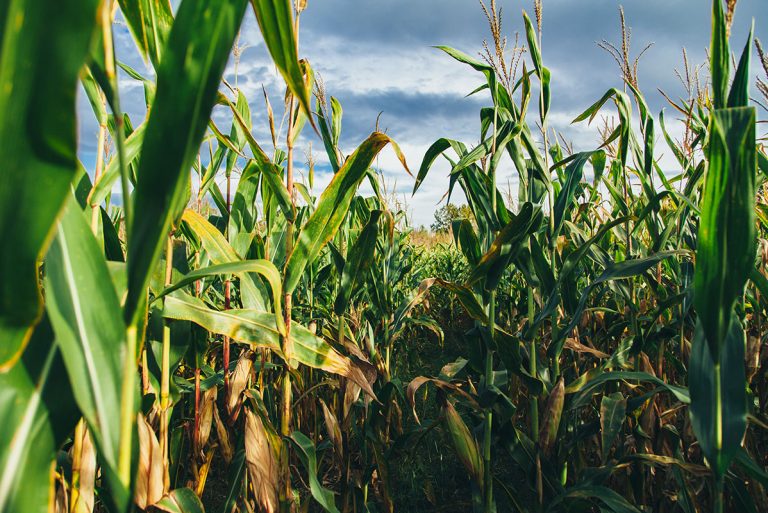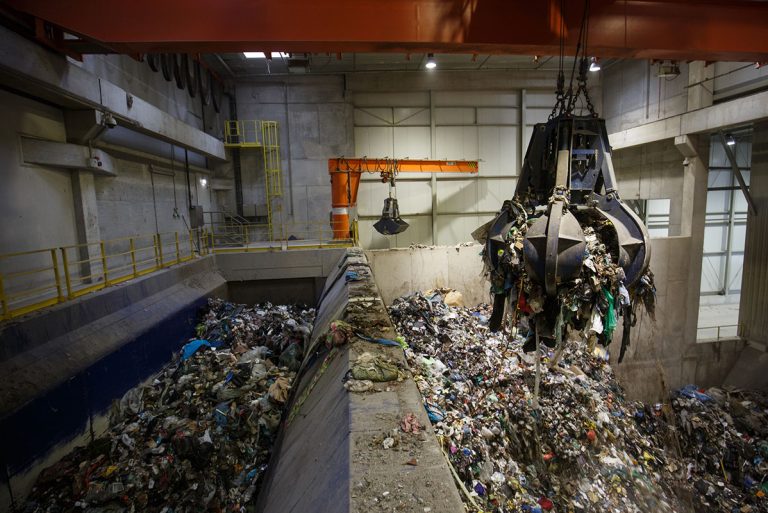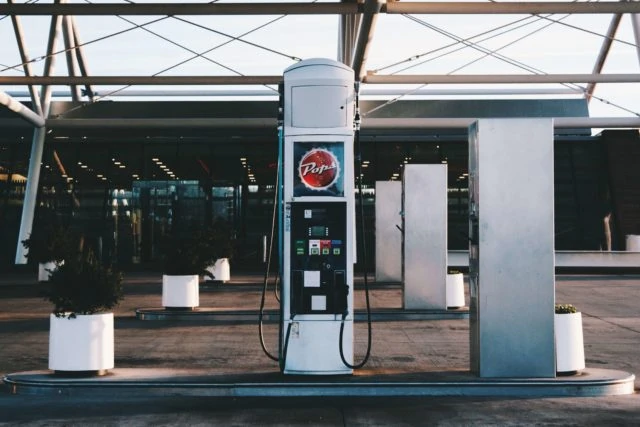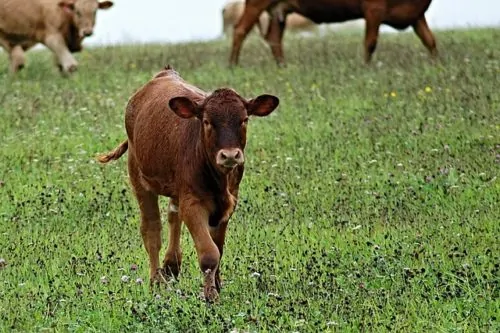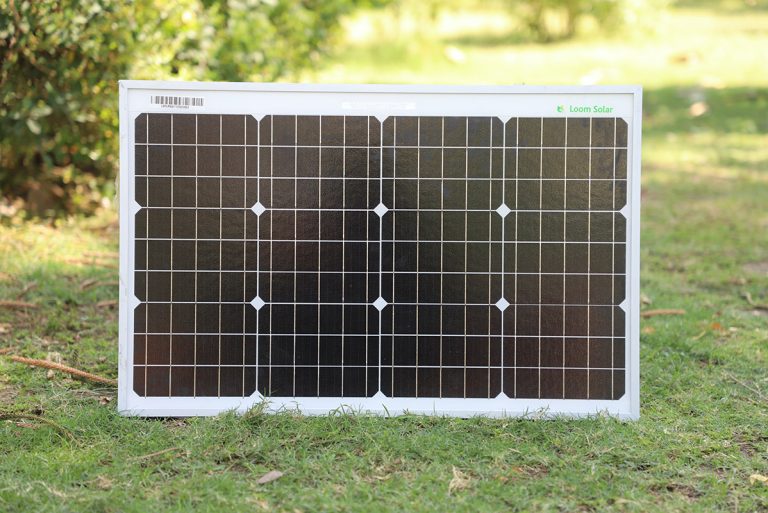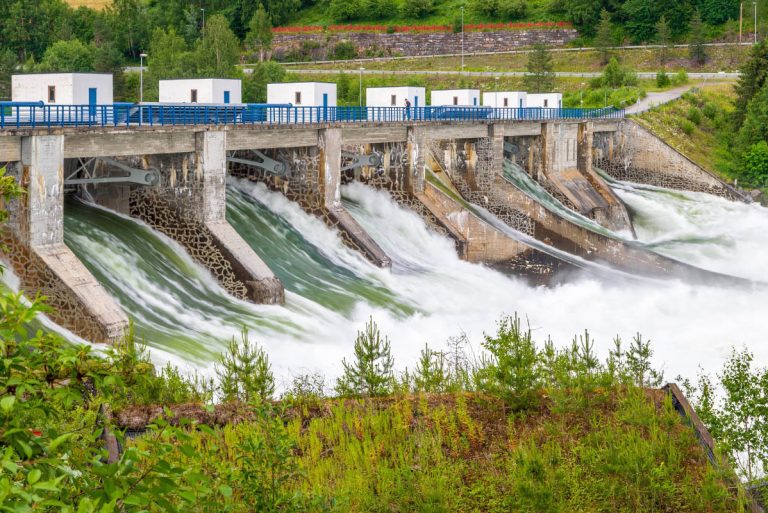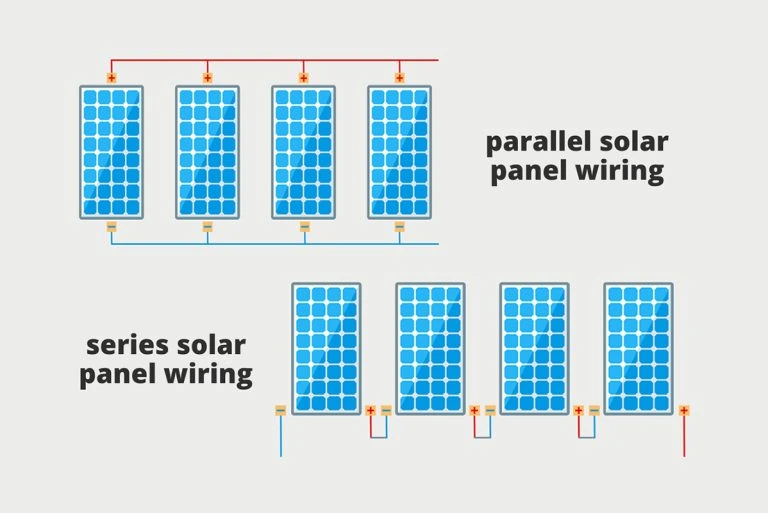As Londoners experienced Storm Eunice in February 2022 and Coloradoans discovered with the Marshall Fire in December 2021, wind energy is powerful. Gusts of 120+ mph can pack a serious punch. Wouldn’t it be great if humans could properly channel wind as a carbon-free energy source?
Like many clean energy advocates, world leaders are recognizing the huge potential of wind turbines to generate renewable energy. United States President Joe Biden, for example, is accelerating offshore wind leases all over the country.
Market analysis for 2022-2027 by Mordor Intelligence forecasts that the wind turbine industry will experience a compound annual growth rate (CAGR) of more than 10%, which is considered quite good.
So, it certainly makes perfect sense that humans exploit wind as a domestic, renewable energy source. But at what cost?
Over the last few decades, wind energy on both utility scale and residential levels have become more popular. Along with their increased prevalence comes lowered costs of wind turbines and increased government incentives to go green with wind.
This is great news!
In this article, you’ll discover how much wind turbines cost today. You’ll also find an analysis of the costs and benefits in terms of energy savings from a wind turbine.
Wind turbine costs: an overview
Utility wind turbines cost millions of dollars each. For example, a wind turbine with a nameplate (rated) capacity of 1 MW could go for $1.3-$2.2 million.
On the other hand, a residential wind turbine producing under 100 kilowatts costs about $3,000-8,000 per kilowatt of capacity.
How are these price tags broken down?
The schema below shows the relationships between wind turbine costs and benefits, and how the levelized cost of energy (LCOE) — as the bottom line or metric in an economic evaluation of wind energy — is determined.

Wind turbine components
Given the sheer size of wind turbines, literally tons of materials — including steel, fiberglass, iron, copper, aluminum, and plastic — are required to construct the major components of a wind turbine.
In the tables and graphs below, this cost is noted simply as turbine.
Wind turbine operations and maintenance (O&M)
Additionally, anchoring the turbines during installation in a location to withstand high wind gusts and sometimes ocean waves is an expensive project in itself. Installation is part of a balance of system cost — along with electrical infrastructure and assembly — noted in the table and graph below.
Wind turbine operations and maintenance costs
Daily operations and regular maintenance (O&M) costs represent other steep financial outlays and are noted as O&M below.
Wind turbine financial costs
Lastly, the cost of a wind turbine must include insurance and construction financing, together referred to as financial costs in the following graphics.
The tables and graphs below list estimated costs for different wind turbine systems as determined by the National Renewable Energy Laboratory (NREL) using 2019 data. Values may fluctuate over time especially as steel markets are volatile.
The values are based on typical wind turbines in use today. On the other hand, newer wind turbine technologies, such as carbon fiber, are more expensive. Engineering designs that eliminate the need for certain turbine components — such as a transition piece — tend to drive down costs.
| Cost Category | 2.6MW onshore | 6.1MW offshore fixed bottom | 6.1MW offshore floating | 20kW residential distributed | 100kW commercial distributed |
|---|---|---|---|---|---|
| Turbine | 991 | 1,301 | 1,301 | 2,575 | 2,530 |
| Balance of System | 336 | 2,131 | 3,237 | 3,100 | 1,770 |
| Financial | 120 | 645 | 790 | – | – |
| O&M | 43 | 124 | 130 | 35 | 35 |

Other modeling studies by NREL present a series of mathematical equations that may help investors or industry professionals doing a life cycle assessment or cost-benefit analysis to calculate the costs of wind turbines.
Wind turbine costs: a breakdown of the major parts
Wind turbines of all sizes contain these three major parts. One utility wind turbine could cost $1 million or more depending on its energy capacity. Approximately 75-80% of that may be for the wind turbine itself.
Wind turbine main components:
- Rotor blades and hub – Like an airplane’s wings, the blades capture wind energy and transfer it to the hub which connects to the turbine’s main shaft.
- Generator and gearbox (inside the nacelle) – Integral to the wind turbine’s drivetrain, the gearbox ramps up the blades’ rotational speed enough so the generator can produce electrical energy.
- Tower – steel or concrete support for the moving parts of a wind turbine.
According to WindEurope, the tower of a wind turbine is the most expensive part of a turbine. It costs 26.6% of the total.
The rotor blades of a wind turbine are the second most expensive part of the turbine, costing 22% of the total. A National Renewable Energy Laboratory (NREL) report estimates utility-scale blades cost $150,000 or more.
Thirdly, the gearbox is estimated to account for 13% of the total turbine cost.
Two inner parts of the wind turbine responsible for creating electrical energy — the power converter and the transformer that converts DC electrical current to AC current — are also costly, coming in at 5% and 3.6% of the total wind turbine price tag.

Wind turbine costs: manufacturing and installation
A 2015 National Renewable Energy Laboratory (NREL) report provides a percentage breakdown of commonly used wind turbine materials. (Note: Values are ranges only. They will vary depending on turbine manufacturer and turbine model.)
| Material | Percentage (%) |
|---|---|
| Steel | 66-78 |
| Fiberglass/plastic | 11-16 |
| Iron | 5-17 |
| Copper | 1 |
| Aluminum | 0-2 |
Wind turbine tower materials
Today there are three main types of wind turbine towers:
- Tubular steel
- Lattice steel
- Concrete
In most cases, sections of the tower are built offsite and transported to the wind project site where they are assembled, often up to 200-300 ft. in height, similar to the Statue of Liberty in New York City!
The tower is the first part of wind turbine assembly which may take several days to finish.
Wind turbine nacelle materials
Positioned on top of the tower is the nacelle, a fiberglass-steel housing of all the inner parts of the turbine.
When completed, the nacelle may weigh 300 tons and span 50 ft. or more.
Inside the nacelle are the gearbox, generator and related equipment responsible for energy conversions. First in the nacelle, the kinetic energy of the wind is converted into mechanical energy used to turn the blades. Then the mechanical energy is transformed into electricity.
Wind turbine rotor blade materials
Today, the predominant materials in wind turbine blades are glass or carbon fibers encased in plastic.
Other lightweight materials, including balsa wood or aluminum, may be used, typically placed in the hollow core.
Wind turbine blades have gotten longer over time. Today, a length of 170 ft. or longer is typical for a utility scale wind turbine blade, while a residential wind turbine blade may be only 25-50 ft. long.
A major reason for the increasing length is their greater energy capacity as the diagram below illustrates.

Currently, a three-blade turbine spinning on a horizontal axis is the most common wind turbine. Egg beater-like wind turbines operating on a vertical axis are not yet in widespread use.
To given you a better idea of what’s involved in manufacturing and installing a wind turbine from start to finish, here’s a time lapse video that shows the complexity:
Wind turbine costs: operation and maintenance (O&M)
Like anything with movable parts, wind turbines require regular maintenance for proper operation. Lubrication and a periodic oil change — like for a car – are just for starters.
This is expensive, especially given the difficulty of accessing the parts on a wind turbine in action. Not only is it hazardous, it’s logically tricky to transport the spare parts — assuming they’re available — to the remote location.
Think of a 150-ft. blade being helicoptered in, for example, to a distant ocean site. Then you need a jack-up barge or a crane ship in order to perform the blade replacement.
Not to mention a very courageous human technician!

A 2021 article in the journal Applied Sciences, states that the operations and maintenance (O&M) costs for wind turbines is approximately 20-30% of the total levelized cost of electricity (LCOE) of current wind systems.
The good news is that both the LCOE and the O&M have fallen in recent years for both onshore and offshore wind projects between 28% and 52%. However, the process of both preventive and corrective maintenance is far from streamlined. Much more research, such as on spare part planning, is required, before those costs fall even more.
Given that onshore wind turbines have a functional life of 20 years while an offshore wind turbine can operate for 25 years, the wind turbine industry would benefit enormously by perfecting seamless O&M, thereby making it more attractive to investors.
Wind turbine industry: growth and trends
Due to a growing worldwide demand for clean energy, the wind turbine industry is slated to undergo widespread expansion in the 2020s.
Wind turbine industry leader
Currently, Asia Pacific is both the largest and the fastest growing market for wind turbines in the world.
However, the Covid-19 pandemic has negatively impacted the wind turbine industry. In fact, there have been 30% fewer wind energy installations worldwide in the last two years than were forecasted by industry experts.
According to the Global Wind Energy Council (GWEC), the offshore wind industry installed only 6.1 GW in 2020, down slightly from 6.24 GW the previous year.
For the third consecutive year, China dominated the world in new wind installations totalling more than 3 GW of offshore wind in 2020.
In fact, China is currently installing its biggest offshore wind farm called the Shapa. So far, it’s over 700 GW in capacity — and this represents only the first two of five stages of the mega-project.
Wind turbine industry developments
New developments in manufacturing and installing offshore wind turbines are destined to make this segment of the wind turbine industry see significant growth in the next several years. For example, advanced, lighter materials allow taller turbines to be constructed and installed safely.
Taller turbines necessitate longer blades that can sweep more wind into rotation. The wind at these higher altitudes is less turbulent, resulting in more efficient energy production.
Plus, improved blade airfoils enhance the efficiency at capturing wind energy per rotation even more.
Wind turbine installations: forecast
The current state of the wind turbine industry is so good that the GWEC, the largest wind energy industry trade group, intends to install 380 GW of offshore wind by 2030, and 2,000 GW by 2050.
That’s a lot of wind power!
In 2022, a 950 MW wind array, the Moray Firth East in the North Sea, is due to be fully activated. An estimated $3.3 billion investment is bringing it to life.
The U.S. Departments of Interior, Energy, and Commerce announced in March 2021 a commitment to install 30 GW of offshore wind by 2030. This power is sufficient to meet the annual energy needs of 10 million+ homes.
2021 U.S. Department of Energy wind reports: latest trends and stats
In 2021, the U.S. Department of Energy (DOE) released three wind reports. All of them build on the fact that advances in wind turbine technology are leading to greater power output at reduced costs.
Here are a few of the major conclusions of those reports:
- Since 2019, average nameplate capacity of newly installed wind turbines grew by 8% to 2.75 MW.
- 16,836 MW capacity of new, onshore wind power was added in 2020 across 25 states.
- Wind turbine prices have dramatically declined in the last decade from $1,800/kW to $770/kW.
- Numerous coastal states on the Eastern seaboard are rapidly expanding their offshore wind capacities, representing a 24% increase over the previous year to 35,324 MW planned or in progress.
- Agricultural and residential owners made up the largest percentage of distributed wind projects, at 36% and 24% respectively.
- Small wind retrofits — for example, installing an upgraded turbine on an existing tower — are becoming popular, making up 80% of all small wind capacity installations.
Find out what these report highlights mean for you as a farmer, homeowner, or business in the next section.
Wind turbine costs for homeowners, farmers, and small businesses: an overview
If you’re interested in renewable energy to power your home, farm, or small business, investing in a wind turbine — either on your property or through a community sharing program — may be to your advantage.

As mentioned previously, wind turbine costs as well as rates for electricity generated via wind energy are at all-time lows and expected to get even better in the near future.
Doing a retrofit of new blades on an existing tower is a highly cost-effective option in this scenario.
That is, if you’re in a region with steady winds of at least 10-12 mph up to 55 mph — after which the turbine ceases functioning to prevent damage — and own at least one acre of land, wind turbines for energy are worth looking into compared to solar. (Assuming your local zoning codes permit wind turbine projects.)
Homeowners have the option of using a certified professional installer or DIYing it with a wind turbine kit for home energy.
For more detailed information on small-scale wind turbine projects, check out the National Renewable Energy Laboratory’s report on this topic.
Residential wind turbine costs: estimate
For an average-sized home and energy demands of 10 kWh/yr. of wind power capacity, a free-standing or roof-mounted wind turbine will cost approximately $50,000 before any tax incentives or company rebates. If your area’s wind speed is below 10-12 mph, experts advise that it’s not economically worth it.
Just as with grid-tied home solar systems, net metering and battery storage are options to make wind energy more attractive — and usually more cost-effective — to skeptical homeowners.
Wind turbine incentives: residential and small businesses
There are federal and state incentives of up to 30% of expenditures available for certain wind projects. To find out more about state rebates, visit the Database of State Incentives for Renewables and Efficiency (DSIRE). For federal programs, begin your research at the DOE’s wind energy funding page.
For farmers and country landowners, the Rural Energy for America Program (REAP), sponsored by the U.S. Department of Agriculture (USDA), offers a variety of grants and guaranteed loans for energy efficiency projects including wind energy.
Residential wind turbines: alternative programs
Even if a private wind turbine is cost prohibitive, you may consider joining a local distributed wind network or community wind program. These enable you to participate in the green energy revolution without making a huge financial investment.
Farmers and other landowners may lease their land as a wind farm and make money in the process, much like a solar farm does for its owner.
Off-grid wind turbine costs: small-scale uses
For smaller scale uses while camping or RVing, you may find a wind turbine generator that meets your energy needs for about $300-500. They function like a solar generator but rely on wind strength to produce electrical power instead of on sunlight.
Wind turbine ROI: energy savings from wind energy
When calculating the return on investment (ROI) of a wind turbine, it’s important to figure in an approximate 50% efficiency (at most) depending on your area’s wind speed and regularity. Using a power curve that takes into account natural wind speed fluctuations rather than the nameplate capacity (rated at 100% peak performance) will improve accuracy of your ROI calculation, too.
It’s possible to achieve a payback period of 6 years for a residential wind turbine, although given the large number of variables, it’s difficult to conclude that this is the average payback period for all small scale wind turbines. In fact, often reviewers state that it’s 10-20 years.
A residential wind turbine has an average lifespan of 20 years. For a utility wind turbine, it’s 25 years.
FAQs on wind turbine costs
Here are a few commonly asked questions and responses about wind turbine costs.
Are wind turbine costs too low?
Some wind industry professionals believe that wind turbine costs are falling so much in a short time period that it could hurt the industry in the long run. Listen to the podcast below for more information on this seemingly counterintuitive idea.
Which companies are the top manufacturers of wind turbines?
According to the Global Wind Energy Council (GWEC), wind turbine manufacture is booming worldwide despite a global Covid-19 pandemic.
Danish company Vestas holds the top spot for the fifth consecutive year in wind turbine manufacture. GE Renewable Energy comes in at #2 globally and as the leading domestic manufacturer in the United States, installing 10 GW there in 2020.
For 2020, Chinese Goldwind is in third place worldwide and #1 in China, installing 12 GW domestically.
Does it take more energy to build a wind turbine than it can generate?
It takes some energy to build a wind turbine. However, a scientific study concluded that in 5-8 months, the amount of energy that the wind turbine produces equalizes the energy that went into its manufacture and installation.
So for a utility wind turbine with a lifespan of 25 years, that’s a small carbon footprint and plenty of free, clean energy.
Key takeaways on wind turbine costs
Whether you’re a farmer, business, utility, or homeowner, wind energy as a renewable energy source outweighs the costs of wind turbines when viewed as a long-term investment from an environmental as well as an economic perspective.
However, if you don’t wish to finance your own wind turbine, leasing your land for a wind energy project or participating in a community wind sharing program are just two of the many options available today to homeowners, farmers, and small businesses.
Wind energy is a major part of humanity’s carbon-free energy transition away from fossil fuels and toward a habitable planet for future generations. Considering the numerous costs of a wind turbine outlined in this article, the benefit of preserving humanity’s future far outweighs them.
